





Tropical plants...in Europe? Let's see!
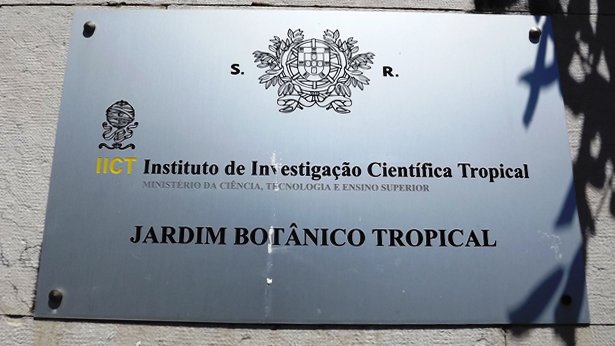
After a visit of the quiet and blue city of Lisbon and a little jaunt out in the fields to meet the oak cork trees, we return to the capital. The area we have to get to is called Belem, situated on the shore of the Tage river and it is famous because of several historical monuments. The Belem tower of course, much sought after by tourists, was built between years 1515 and 1521 to act both as entry door to Lisbon and a fierce defense for the city. Although it is nowadays set on the river shore it was actually built in the middle of the river but the great earthquake of 1755 changed the river bed and hence changed dramatically the architect's idea!
Belem has an important historical feature as this is the place from which the famous Vasco de Gama explorer took off in 1497 in search of the India seaway. The Belem National Palace is also to be found here, it used to be home for the kings of XIIth and XIIIth centuries and now serves for the nation president. The 'Padrao do descubrimentos' (discoverers' monument) is a modern (1960) piece of concrete art set to honor the 500th anniversary of the death of Henri the Sailor (Henrique o Navigador), third son of King Jean the First of Portugal and cornerstone of sea discoveries and Portuguese colonies although he never did sail himself but was clever enough to find money to get expeditions started. The monument is a concrete slab 52 meters high, featuring of course Henri followed by many explorers and seamen. There is also a large monastery, a coach museum, a navy museum, an archeological museum, an electricity museum and the Belem culture center. On a lesser historical interest but worth a visit for the greedy ones, several pastry shops sale the 'pasteis de Belem', a delicious egg tart pastry worth a try!
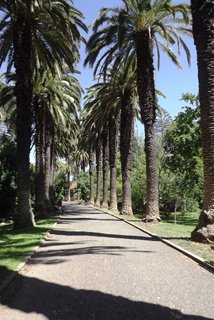
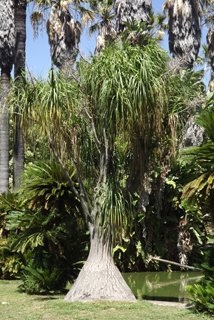

But let us leave all those stones and sweets for a later visit when the sun will be less scorching and for now we can walk to the JBT or Jardim Botanico Tropical (I guess there is not need for translation here!). Also known as 'Jardim do Ultramar' (oversea garden), it is a rather young garden as it was only created in 1906 by King Carlos 1. The garden obviously has had better days regarding maintenance and general care but is still a pleasant place to visit notwithstanding many negative feedback by travelers (Lisbon is not London nor Singapore!) Now, it is not only a nice garden with majestic trees but also home for the institute for scientific tropical research (Instituto de Investigaçao Cientifica Tropical). The buildings also host an herbarium (important works on African flora are done here, among which digitization of old data), a zoological collection and a xylotheque (wood collection). In case you have an interest for dwarfed trees there is a bonsai show in a small yard at the back of the garden. I had a stroll there but could not spot any outstanding pieces. The botanical diversity of species is interesting though but the wire work is awful. Anyway, entry is just two Euros which I guess we can afford, if you are senior or under 18 it will even be only one Euros and free if you are under 7. As stated before, the garden has to do with the Portuguese former colonies (Africa, South America, India and Indonesia) so plants from those places are to be found here, numbering about 400 different species. Many of those plants are endangered in the wild, a preservation program is held by the IICT.
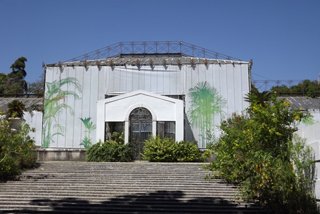
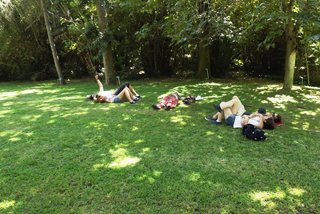
So, let us proceed to the visit now! We have about 15 acres to wander around (about 60.000 square meters). Let's walk on the path to the left after the entrance booth, where we can see quite a few members of the Cycad plants which are considered as live fossils. Members of the Cycadaceae and Zamiaceae have a very peculiar archaic look and really bring one's mind back to dinosaur times, they have at the same time a ferny look and a tough aspect which makes them a living oxymoron! A few yards further there is a nice Beaucarnea recuvarta set close to a pond, the bulk collar seems to float on the background water like a giant cork. Now, this is an impressive sight! The dragon tree, Dracaena draco comes from Canary islands, Cape Verde and Madeira. Judging by the visitor's size one can guess this is a serious tree although a member of the monocotyledon tribe. The sprinklers are a welcome thing as they make the Lisbon heat more bearable, adding freshness to the already cool and soothing atmosphere of the garden. Not a surprise then to see those harried tourists laying on a patch of lawn, close to dutifully identified trees. The next point of interest for us now comes from the superficial roots of a large Ficus macrophylla, those large grey bulky roots look like some weird pachyderm holding on to the earth.
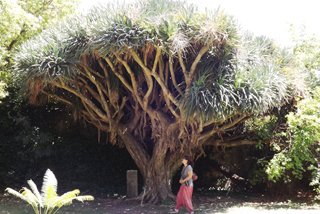
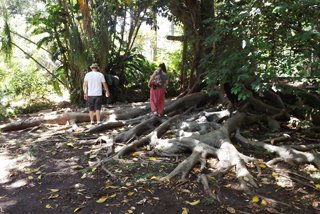
A large palm alley leads to the greenhouse which looks nice and attractive from afar but alas proves to be closed on reaching it, no way to check on the marvels grown in there. As a consoling treat let us turn to palm trees which are represented by quite a few species throughout the garden. Look at this nice flowering solitary one, the erect and dropping inflorescence is a whole lesson on elegance. But would mind having a good look at this strange looking tree, I saw another specimen yesterday in the street and could not identify it, any clue ? It has a very bulky and multi-trunked basis which seems rather unique to me in the tree world and makes an outstanding criteria, the fruit clusters also have a peculiar aspect. Let us walk through the Aleurites moluccana thicket, those nice trees which belong to the Euphorbiaceae family and are found as well on Reunion island. If you ever come to my island during hurricane season you will admire their leaves turning silver. This handsome tree originates from the Molucca islands as stated by its species name, it produces amazing nuts which shells can be polished like jewels.
And we are now back to the garden entrance, let us walk back to the river and have a sip in one of the many outlets set there. Does anyone care for a real fresh Sagrés cerveja? Good!
Copyright © www.100flowers.win Botanic Garden All Rights Reserved